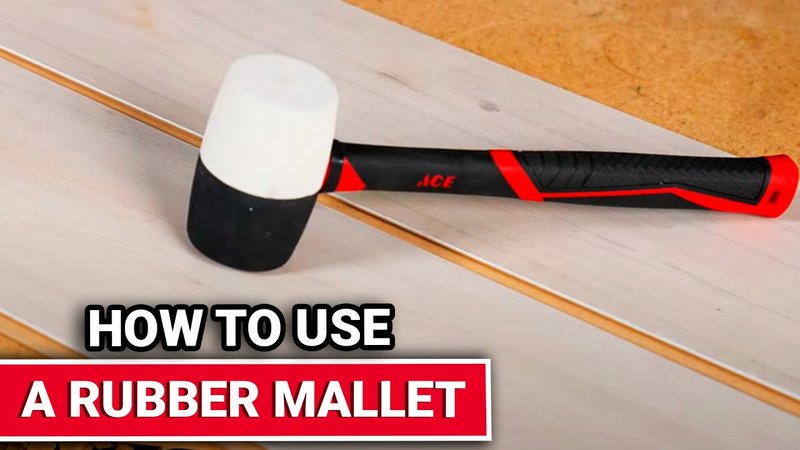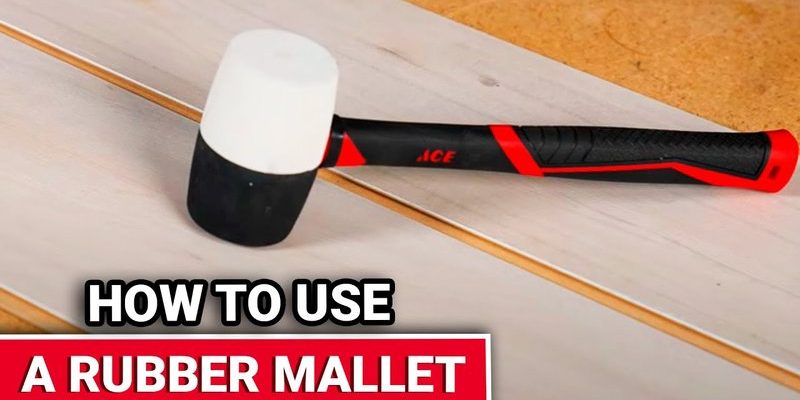
Imagine you’re trying to fit a new component into your entertainment center, and it’s just a hair too snug. A soft mallet, like the ones made by brands such as Estwing or Stanley, can help you make those delicate adjustments without risking damage. You get the precision you need without the worry of dents or splinters. Let’s dive into how you can wield this tool like a pro.
Understanding What a Soft Mallet Is
A soft mallet typically has a head made of materials like rubber, plastic, or foam. This design helps absorb shock, making it ideal for tasks where precision and gentleness are key. When you hit something with a soft mallet, it delivers a softer blow than a traditional hammer, which helps prevent damage to the workpiece you’re adjusting.
You might be wondering why not just grab the nearest hammer. While a regular hammer is great for driving nails or larger tasks, it can cause dents or splits in softer materials like wood or plastic. That’s where the soft mallet shines. Its cushioned strike is perfect for nudging hardware into place without the risk of ruining the integrity of the material you’re working on.
In addition to woodworking, a soft mallet can also help in tasks involving metal parts, such as when assembling or adjusting hardware components. It can help ensure that everything fits together snugly, without causing any unnecessary wear or tear.
Choosing the Right Soft Mallet
There are several factors to consider when picking the right soft mallet for your job. The first thing to look at is the weight. Generally, most soft mallets weigh between 8 to 16 ounces. For lighter tasks, a smaller mallet can deliver adequate force without being bulky. But for more stubborn pieces, you might want to opt for a heavier model that still offers a gentle touch.
Next, consider the head material. Rubber mallets are the most common choice due to their versatility and durability. They provide a great balance of firmness while still being gentle enough on surfaces. Plastic mallets are another option: they’re lightweight and great for precision work. Lastly, foam mallets can be the softest option, perfect for very delicate surfaces that need a soft touch.
Beyond the weight and material, the shape of the mallet head can affect your control. A flat head is great for even strikes, while a rounded head can give you more precision when working in tight spots.
How to Use a Soft Mallet Effectively
Using a soft mallet might seem straightforward, but there’s an art to making the most of it. Here’s how to get started:
1. Align Your Workpieces: Before you strike anything, ensure that the pieces you’re working with are properly aligned. Misalignment can lead to frustration and may require even more adjustments down the line.
2. Gauge Your Force: Start by holding the soft mallet lightly and assess how much force you’ll need. You want to use just enough power to nudge the piece but not so much that you risk damaging it.
3. Strike with Precision: When you’re ready to strike, aim carefully. A light tap is often all you need. If you find yourself needing to use more strength, check to see if there’s any obstruction or misalignment before continuing.
4. Assess the Adjustment: After each tap, take a moment to reassess the fit. Sometimes, less is more. After a few gentle nudges, you could find the adjustment made a big difference without much effort.
Using a soft mallet is much like any technique in life—practice makes perfect. The more you use it, the more you’ll get a feel for how much force to apply and where.
Common Applications of a Soft Mallet
There are numerous scenarios where a soft mallet can come in handy. Here are a few common applications where it shines:
– Assembling Furniture: When putting together furniture, especially items like dressers or shelves, a soft mallet helps ensure parts fit snugly without damaging the surface. Think of it as persuading the pieces to come together harmoniously.
– Adjusting Doors: If a door is sticking, a soft mallet can help align it without causing dents or damage. A few gentle taps on the hinges can often solve the issue without a complete fix.
– Tiling Work: For tilers, a soft mallet is crucial when setting tiles and ensuring they’re level. It lets you adjust tiles gently and accurately, making the whole process smoother.
– Crafting: In crafting, especially when working with delicate materials, a soft mallet can help you connect pieces without the risk of splintering or crushing them.
These examples show how versatile and valuable a soft mallet is in everyday hardware adjustments. Whether you’re home improvement-minded or just love a good DIY project, investing in one can be a game changer.
Maintaining Your Soft Mallet
Proper care can extend the life of your soft mallet and keep it performing well. While they’re designed to take a beating, a little maintenance goes a long way. Here’s how to keep your mallet in top shape:
1. Keep It Clean: After you’re done using your mallet, wipe down the head and handle to remove dirt, dust, or grease. A simple cloth will do wonders, keeping it looking and working as good as new.
2. Store Properly: When you’re not using your mallet, find a good spot for it. Hanging it up or storing it in a toolbox helps avoid accidental damage.
3. Inspect Regularly: Every now and then, check the mallet for any signs of wear and tear. If the head shows significant signs of cracking or wear, it’s time to replace it.
Taking care of your tools, including your soft mallet, not only ensures they last longer but also performs better when you need it most.
Soft Mallet vs. Hard Mallet: When to Use Each
Understanding when to use a soft mallet versus a hard mallet is crucial. Each serves different purposes, and using the right one can make your task easier.
– Soft Mallet: As we’ve discussed, soft mallets are great for gentle adjustments, precise work, and protecting surfaces from damage. Use it when working with softer materials, furniture, or delicate items where a gentle touch is needed.
– Hard Mallet: Hard mallets, typically made from wood or metal, deliver more power. They’re ideal for driving stakes, chisel work, or any task where you need significant force. However, they can easily damage softer surfaces, so they’re best used in situations where impact won’t matter.
The key takeaway? Knowing your materials and the task at hand will help you decide which type of mallet to grab. It’s all about making the right choice to get the job done effectively.
In conclusion, using a soft mallet for gentle hardware adjustments is all about finesse and control. By choosing the right mallet, applying gentle strikes, and maintaining your tools well, you’ll find that even the trickiest adjustments become a breeze. Happy DIYing!
